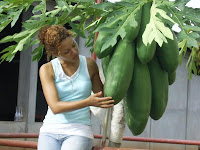Papaya | Agriculture | Papaya is a palm-like tree stem soft evergreen, Carica papaya, is native to tropical America but now grown in tropical and warm semi-tropical areas around the world. Papaya is also the name of the big, juicy, melon-like, edible fruit of this tree, which has black seeds in the center and usually varies in color from yellow to a yellow tint.
The papaya fruit is both delicious and nutritious. It provides several vitamins and minerals in significant amounts, is low in calories, and has an enzyme that is useful in tenderizing meat and for treatment of indigestion (Herbst 2001; Prior 2007). The succulent fruit with its unique flavor, texture, shape, and color adds to the sensual joy of humans. Beyond these nutritional, commercial, and aesthetic values for people, the trees and fruits also offer ecological values, providing food and habitat for insects, birds, and other animals. Thus, while the fruit and flowers of the papaya tree provide for the species individual purpose of reproduction, they also offer larger values for the ecosystem and for people.
The papaya also is known as fruta bomba (Cuba and parts of Caribbean), lechosa (Venezuela, Puerto Rico, the Philippines, and the Dominican Republic), mamão, papaw (Sri Lankan English), papol\guslabu (tree melon in Sinhalese), and tree melon, as well as 木瓜 (tree melon) in Chinese and đu đủ in Vietnamese. It also is sometimes called the pawpaw (sometimes spelled papaw), although this common term more accurately applies to the small trees with large fruit of the genus Asimina.
Carica, the genus to which the papaya belongs, is a taxa of flowering plants in the family Caricaceae. Formerly treated as including about 20-25 species of short-lived evergreen shrubs or small trees—growing to 5-10 meters tall and native to tropical Central and South America—recent genetic evidence has resulted in the genus being restricted to the single species Carica papaya (papaya; syn. C. peltata, C. posoposa). Most of the other species have been transferred to the genus Vasconcellea, with a few to the genera Jacaratia and Jarilla.
 The papaya, Carica papaya, is a small tree, with the single stem growing from 5 to 10 meters in height. It is considered a horticultural wonder in that it grows from a seed to a seven meter (20 foot), fruit-bearing tree in less than 18 months (Herbst, 2001). The tree is usually unbranched if unlopped.
The papaya, Carica papaya, is a small tree, with the single stem growing from 5 to 10 meters in height. It is considered a horticultural wonder in that it grows from a seed to a seven meter (20 foot), fruit-bearing tree in less than 18 months (Herbst, 2001). The tree is usually unbranched if unlopped.The papaya has spirally arranged leaves confined to the top of the trunk. The leaves are large, 50-70 centimeters (cm) diameter, deeply palmately lobed with 7 lobes. The lower trunk is conspicuously scarred where leaves and fruit were borne. The flowers are similar in shape to the flowers of the Plumeria but are much smaller and wax-like. They appear on the axils of the leaves, maturing into the fruit.
Papaya tends to be large, being about 15-45 cm long (6 to 17 inches) in diameter and 10-30 cm (4-12 inches). Variety grown only in Hawaii and Florida, and especially popular in the United States is a pear-shaped, golden yellow variety that reaches about 16 centimeters (6 inches) and 1 to 2 kilos in weight (Herbst, 2001). The fruit has a large area that is full of shiny, grayish-black seeds, which are also edible, but generally not eaten (Herbst, 2001). The papaya fruit is ripe when it feels soft (like a ripe avocado or a bit soft) and his skin has taken on an amber orange. The result is vaguely similar to pineapple and peach, although much milder without the acidity and creamy texture and a slightly more mature melon. - AGRICULTURE
Papaya





No comments:
Post a Comment